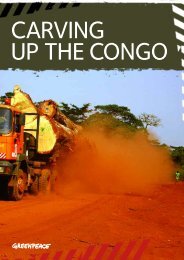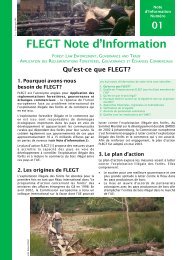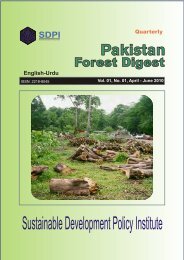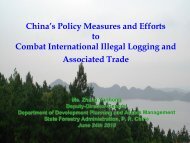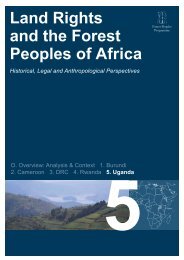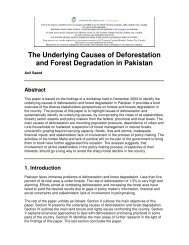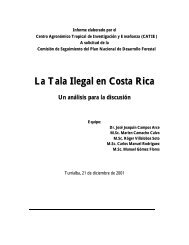CHAINSAW MILLING IN GHANA: CONTExT, DRIVERS ... - Fornis.net
CHAINSAW MILLING IN GHANA: CONTExT, DRIVERS ... - Fornis.net
CHAINSAW MILLING IN GHANA: CONTExT, DRIVERS ... - Fornis.net
- No tags were found...
You also want an ePaper? Increase the reach of your titles
YUMPU automatically turns print PDFs into web optimized ePapers that Google loves.
Chainsaw milling in Ghana: context, drivers and impactsTIDD/FORIG (2009) reported that an average of 84% of the total wood stocked intimber markets across the country was supplied by chainsaw operations (so-called“bush cut”).The 1994 Forest and Wildlife Policy has a clear objective to promote the developmentof viable and efficient forest-based industries so as to fully utilise timber andother products from forest resources to satisfy domestic and international demandfor competitively-priced quality products (1994 Policy, objective 2). At the time theban was enacted, the annual domestic demand for lumber was estimated to be450,000 m 3 (TIDD 2005). When it became apparent that the formal sector was notwilling or able to supply the domestic market, the policy created two specificinstruments to achieve this objective:• special timber utilisation permits (TUPs) to 78 selected small- to medium-scalesawmills to produce lumber exclusively for the domestic market; and• a directive in accordance with section 36 of LI 1649 that all holders of TimberUtilisation Contracts (TUCs) were to supply 20% of their lumber to thedomestic market.In practice, these instruments have largely failed (TIDD 2005; Parren et al. 2007).According to the TIDD (2005) assessment, the dedicated sawmills could notadequately supply domestic markets because their concessions did not have enoughquantities of the desired species; in addition, there was “illegal” export of productsto markets that offered higher prices than the domestic market. The supply gappersisted and continued to be filled by chainsawn lumber. Although communitieshad access to timber as guaranteed by LI 1649 through timber utilisation permits(TUPs), this system was abused and the permits were given mainly to commercialtimber interests (Parren et al. 2007; Davies and Awudi 2001).The process to obtain a commercial harvesting permit (Timber Utilisation Contract)is cumbersome and competitive and the industry — supported by politicians — haslargely succeeded in pressuring the Forestry Commission to circumvent the law andgrant it TUPs instead. 7The GTMO has argued that it has met the 20% requirement for domestic lumberas the directive did not specify products or quality levels. 8 This was in response tocomplaints that the products supplied by sawmills were of lower quality (off-cuts)and did not meet general consumer standards, especially for construction. This claimhas often been rejected by lumber dealers in meetings; they say that even beforethe directive came to force, sawmillers supplied the local market with products thatwere not export grade. Forestry officials argue that the intent of the directive was torequire sawmillers to supply export-grade timber. Sawmillers say they are not ableto meet the 20% requirement because they cannot make a profit if they sell exportgradetimber at prevailing domestic prices.If the patterns of supply from sawmills since the ban are studied, it can be concludedthat the policy response was not adequate in addressing domestic lumber needs.32




